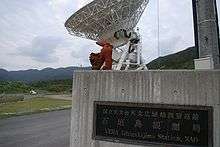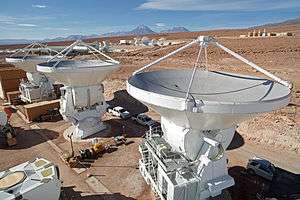National Astronomical Observatory of Japan
The National Astronomical Observatory of Japan (国立天文台 kokuritsu tenmondai) (NAOJ) is an astronomical research organisation comprising several facilities in Japan, as well as an observatory in Hawaii. It was established in 1988 as an amalgamation of three existing research organizations - the Tokyo Astronomical Observatory of the University of Tokyo, International Latitude Observatory of Mizusawa, and a part of Research Institute of Atmospherics of Nagoya University.
In the 2004 reform of national research organizations, NAOJ became a division of the National Institutes of Natural Sciences.
Facilities



- Mitaka Campus (Mitaka, Tokyo. 35°40′31″N 139°32′17″E / 35.6752172°N 139.5380831°E)
- The Headquarters, Astronomy Data Center, Advanced Technology Center, Public Relations Center
- Solar Flare Telescope, Sunspot Telescope, TAMA 300 gravitational wave detector
- Tokyo Photoelectric Meridian Circle
- Historical instruments: Solar Tower Telescope, 65cm refractor dome, 20cm refractor dome
- Nobeyama Radio Observatory & Nobeyama Solar Radio Observatory (Minamimaki, Nagano, 35°56′28″N 138°28′13″E / 35.9410112°N 138.4702528°E)
- 45m Millimeter Radio Telescope, Nobeyama Millimeter Array, Nobeyama Radio Heliograph
- Mizusawa VERA Observatory (Ōshū, Iwate. 39°08′06″N 141°08′00″E / 39.1350952°N 141.1332035°E)
- 20m radio telescope, 10m VLBI radio telescope
- Historical building: Dr. Kimura Museum
- Okayama Astrophysical Observatory (Mt. Chikurinji in Asakuchi, Okayama. 34°34′34″N 133°35′39″E / 34.5760726°N 133.5941148°E)
- 188cm telescope, 91cm telescope, 65cm Coude-Type solar telescope
- VERA 20m radio telescopes
- Mizusawa
- Ogasawara. 27°05′30″N 142°13′00″E / 27.09167°N 142.21667°E
- Iriki. 31°44′52″N 130°26′24″E / 31.7478213°N 130.4399443°E
- Ishigakijima. 24°24′43.83″N 124°10′15.58″E / 24.4121750°N 124.1709944°E
- Hawaii Observatory (Hawaii)
- Subaru 8m telescope (Mt. Mauna Kea. 19°49′33″N 155°28′35″W / 19.825814°N 155.476455°W)
- Hilo Base Facility (Hilo, Hawaii. 19°42′10″N 155°05′25″W / 19.70289°N 155.0902498°W)
Norikura Solar Observatory (Mt. Norikura, Nagano, 36°07′01″N 137°33′09″E / 36.116925°N 137.552528°E), formerly under NAOJ, was decommissioned in 2010 and its building is reused for researches including non-astronomical area under administration of National Institute of Natural Sciences.
NINS
In 2004, NAOJ, in alliance with four other national institutes – the National Institute for Basic Biology, the National Institute for Fusion Science, the National Institute for Physiological Sciences, and the Institute for Molecular Science – established the National Institutes of Natural Sciences (NINS) to promote collaboration among researchers of the five constituent institutes.[2]
Projects with NAOJ involvement
- ALMA, ASTE
- SELENE
- VSOP, VSOP-2
- Hinode (Solar-B)
- SPICA (satellite)
- JASMINE
- Hubble Origins Probe
See also
References
- ↑ "European Antennas at ALMA's Operations Support Facility". ESO Picture of the Week. Retrieved 21 July 2013.
- ↑ NINS outline
External links
| Wikimedia Commons has media related to National Astronomical Observatory of Japan. |
